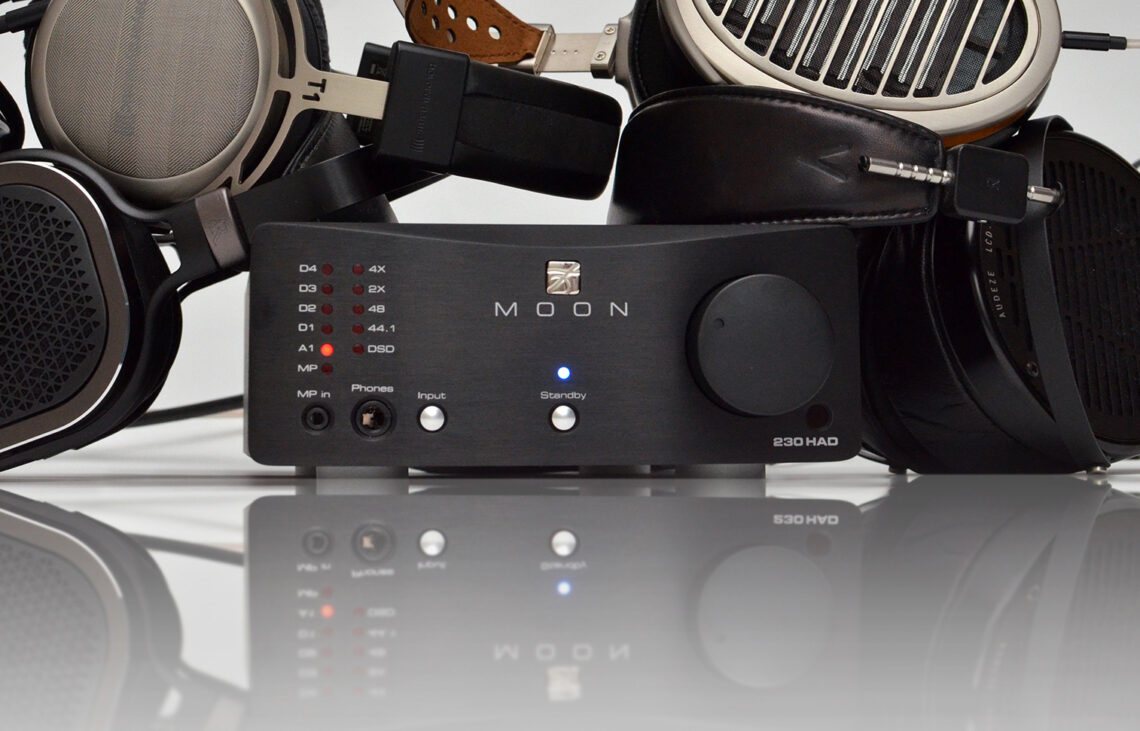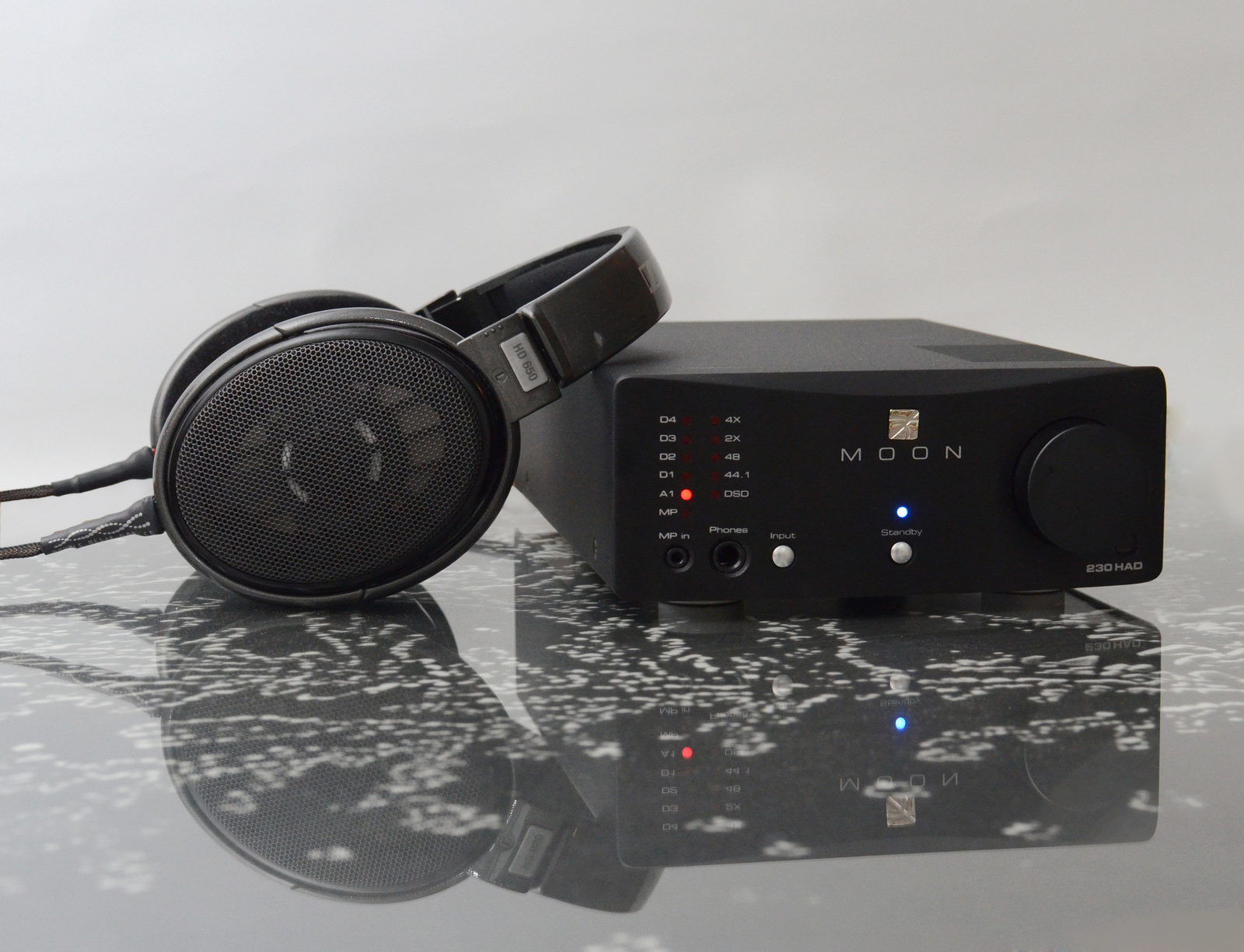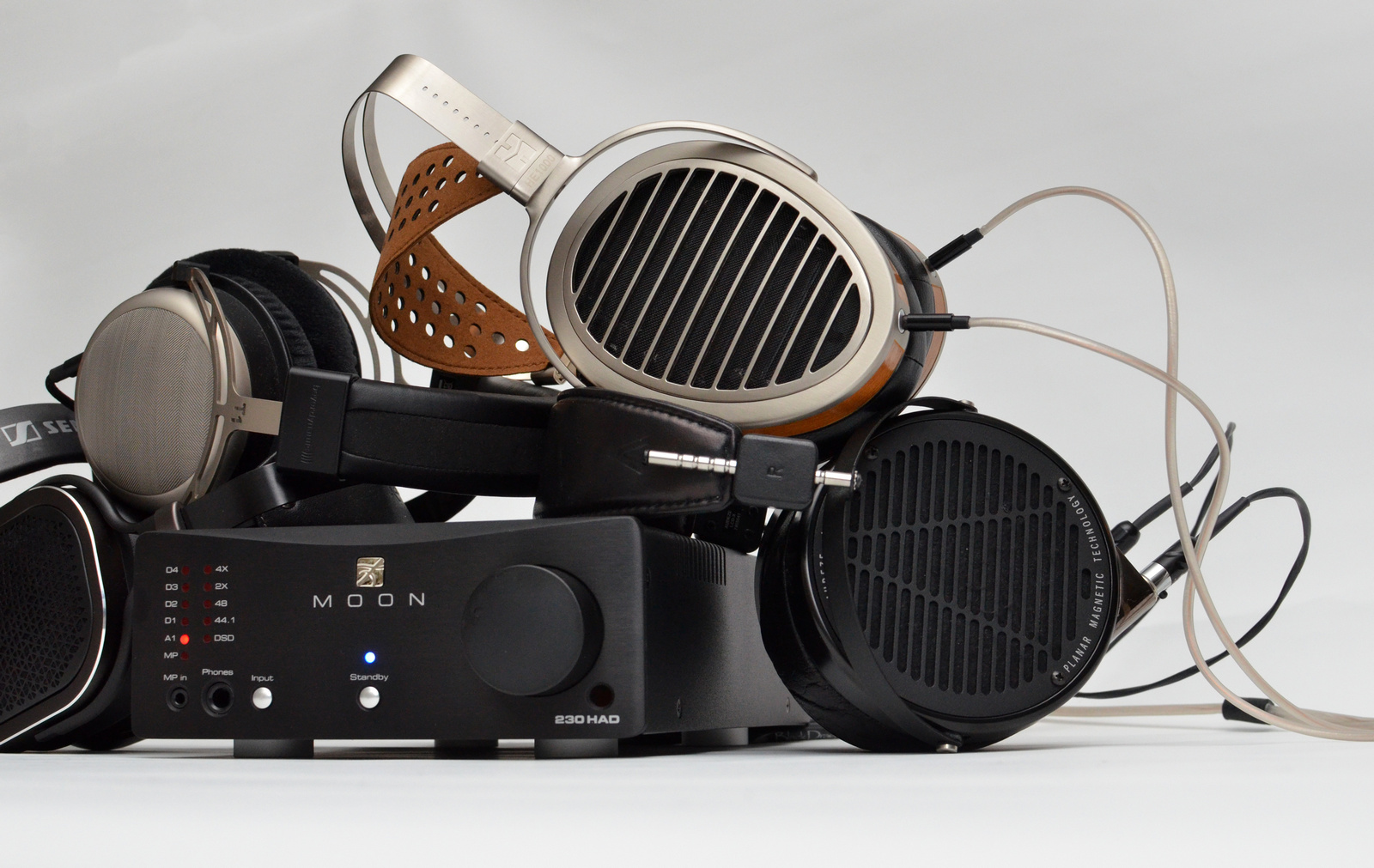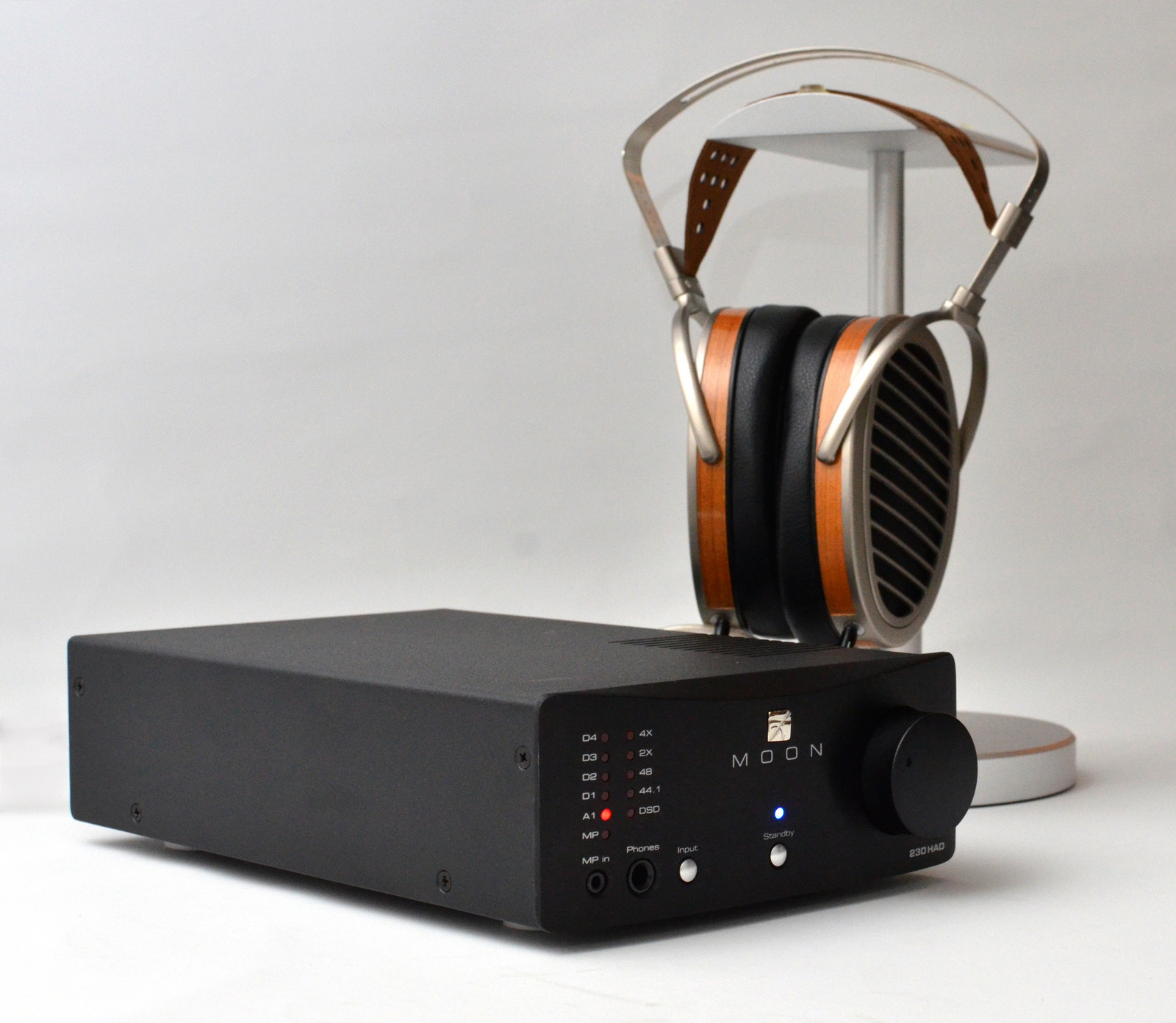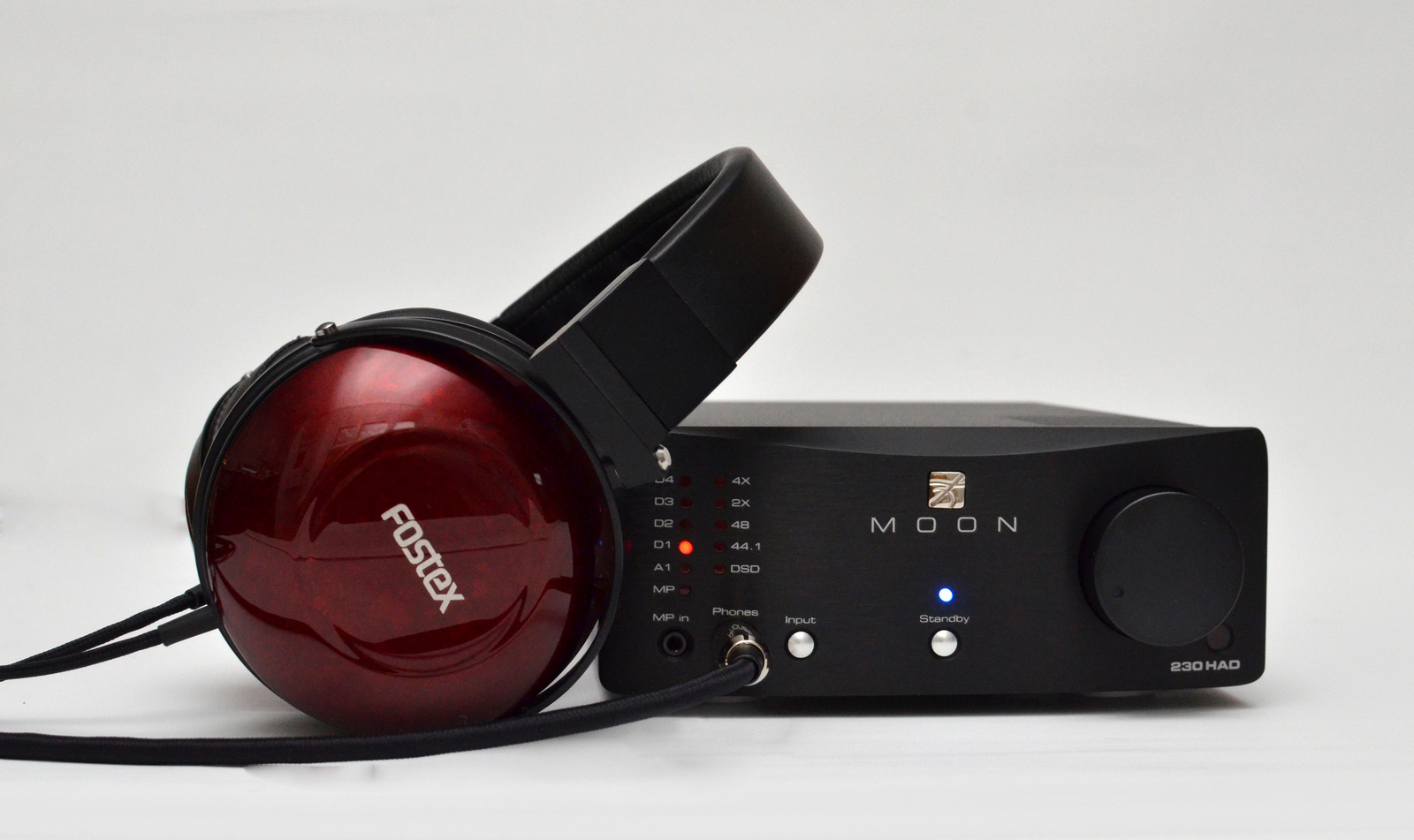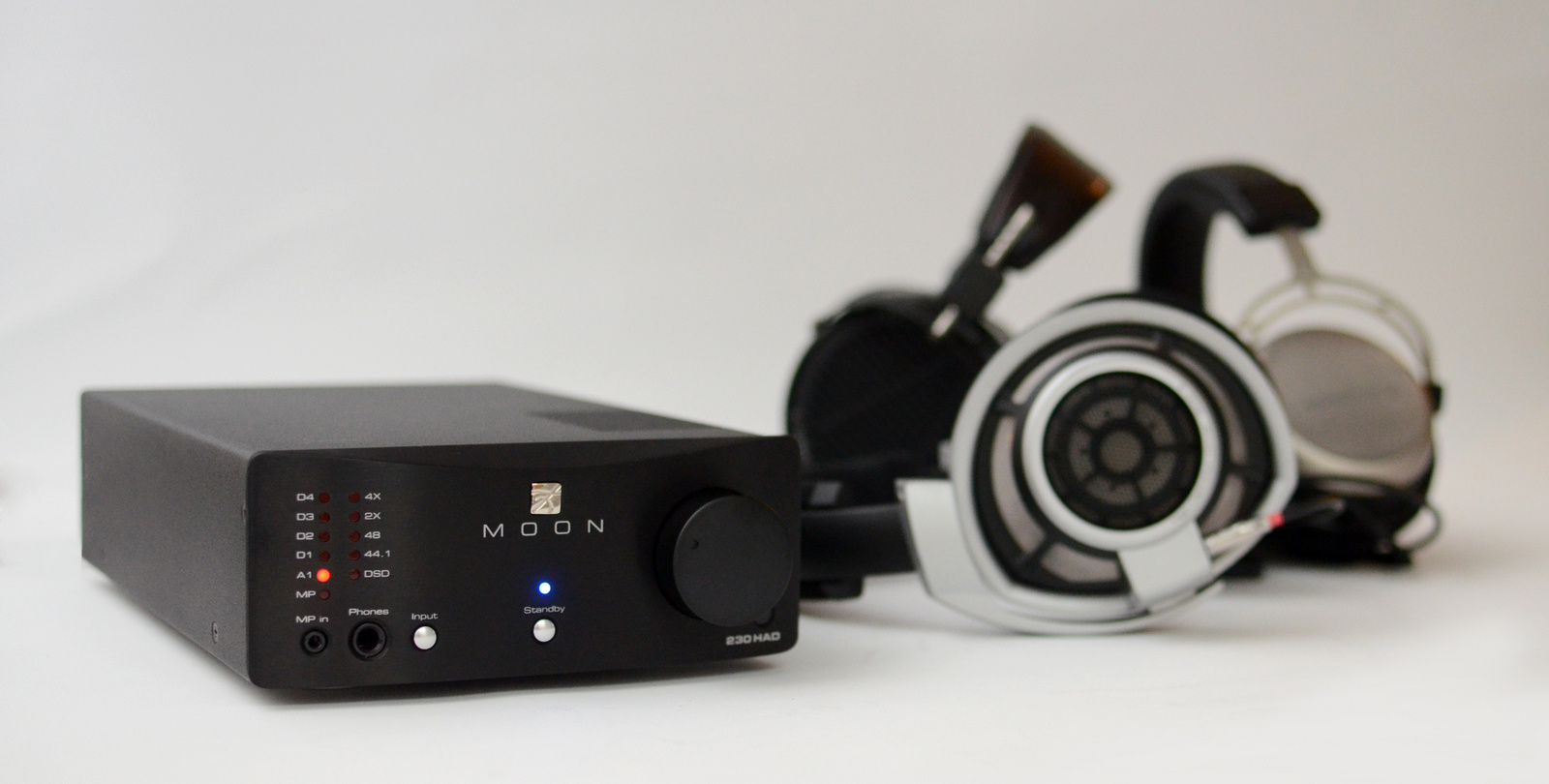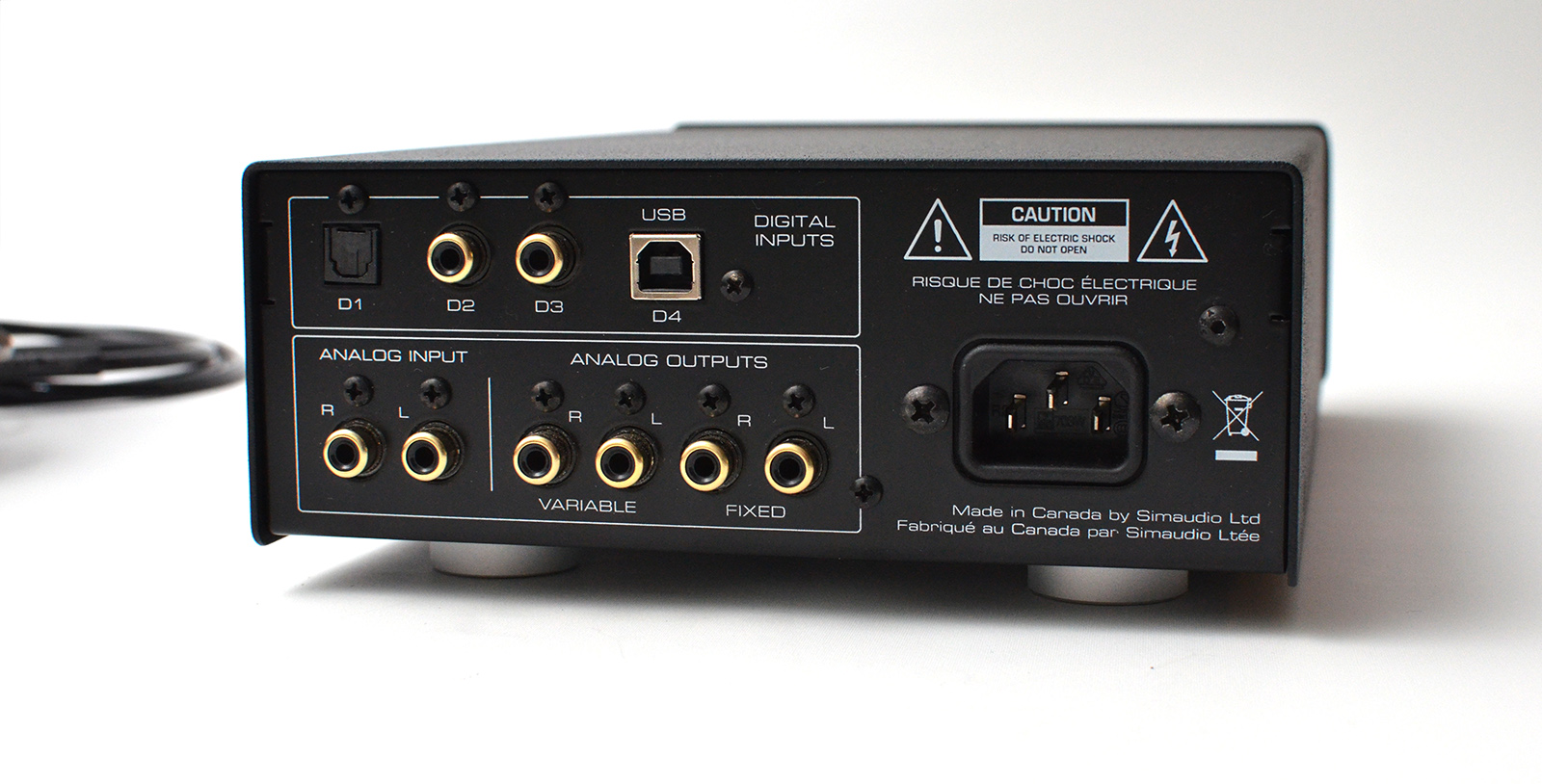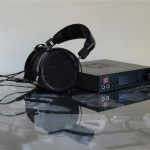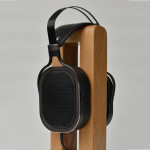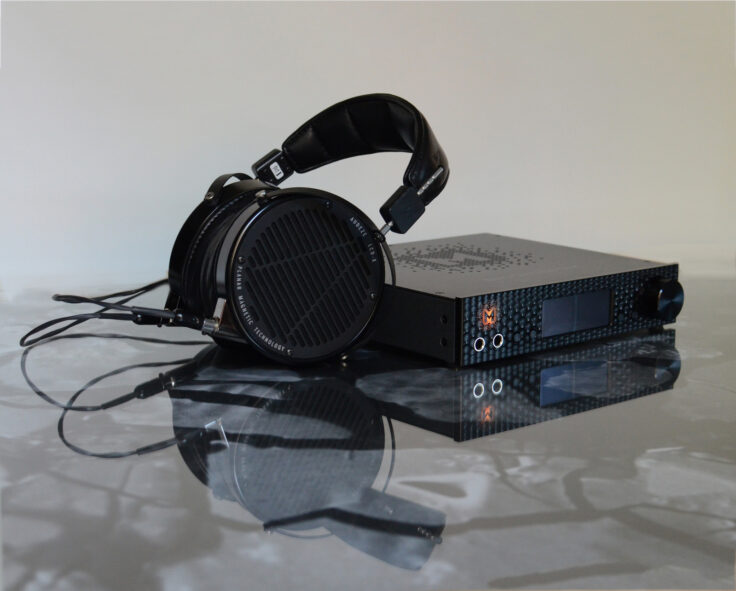The Canadian high-end manufacturer Simaudio has two offerings for headphone enthusiasts, under its brand name “MOON by Simaudio”: The big, expensive and highly praised Moon 430HA amplifier, and the compact and three times less expensive Moon 230HAD. The 430HA has an optional DAC (then it is called 430HAD), the 230HAD comes with a DAC whether you want it or not.
The 230HAD is a headphone amplifier, DAC and pre-amp in one neat compact package. It has a remote control and multiple digital and analog inputs. It is not a total beast like its big brother, but powerful enough for most headphones, outputting 1 watt at 50 ohm. In this review I will test the Moon 230HAD as a DAC/Amp, as well as a standalone headphone amplifier.
Moon 230HAD as a DAC/Amp
– Moon 230HAD vs Burson Conductor V2+
These two DAC/Amps are at the same price point, and having just enthusiastically reviewed the Conductor V2+, I really was curious how the Moon would hold up. I started out comparing them as DAC/Amps, using the built in DAC of each unit.
Oppo PM1
World Town – MIA: I don’t find too much of a difference between these two amps with this track. They are full and nice sounding. The Conductor is maybe a tad crisper, making it feel a tiny tad clearer.
Mi Declaracion – Vinicius Cantuaria: Here the differences are obvious and the preference switch. The Conductor is crisper and feels a tad more open and detailed, but the midrange, especially noticeable in the vocals, is warmer, fuller and generally nicer with the Moon.
Ragged Wood – Fleet Foxes: The Conductor is more open with more air. The Moon has a warmer, but a bit less dynamic, presentation. On this track I tend to prefer the Conductor.
The Water Lets You In – Book of Fears: The Conductor is still clearer and crisper, but the Moon has a nice warmth that compensates in some ways.
Concluding, the Moon seems to have a sound signature that is similar to that of the Oppo – a bit warm, un-bright and a bit forgiving. Together they sound good, but the Conductor comes out as airier, crisper and more detailed. But I sometimes miss that extra midrange magic of the Moon when listening to the Conductor. When I connect the Conductor DAC to the Moon (in other words not using the internal DAC of the Moon), I notice that it clear things quite a bit, making the race more even.
Audeze LCD-2
Irish Blood, English Heart -Morrissey: Again, male vocals comes out more natural sounding with the Moon, whilst the Conductor shows its strength in detail retrieval.
Never Forget The Good Ones – Solveig Slettahjell: When it comes to female vocals, the warmth of the Moon adds some nice vibes, and it has this lushness that really makes me happy. Especially when the acoustic bass comes in, it fills my beloved LCD-2 rev.1´s in a way that the Conductor cannot match, even if it gives me a bit more detail and better texture.
Compare Manuel – Vicente Amigo: The ultra fast flamenco guitar is crisper and better textured with the Conductor, but I´m a sucker for warmth and full bodied sound – so I have a weak spot for the Moon. They aren’t miles apart, though.
Conclusion The Conductor is crisper and more detailed, and drives the LCD-2 very well. So does the Moon, which adds some midrange warmth that, to my ears and preferences, compensates for a slight loss of detail. Again, when connecting the Conductor’s DAC to the analog inputs of the Moon, it becomes apparent that the DAC of the Moon is weaker than the Conductor’s.
Audeze EL-8 Closed Back
Cuidad les Ideas – Vincente Amigo: I listen through most of this fabulous flamenco album, and though they both do a likable job with the EL-8C, I tend to consistently favor the Conductor. It feels more dynamic. The mid-range magic of the Moon does have its appeal, though, especially with vocals.
The Young Vivaldi – RV813 I – Ensemble Modo Antiquo: This string quartet piece shows the difference in tonality between the two amplifiers. The Moon is the warmer, the Conductor is slightly crisper. There isn’t really too much to write about perceived difference in details, I feel they are giving me quite a similar experience.
Almost like The Blues – Leonard Cohen: Unsurprisingly, the characteristic voice of Leonard Cohen has a fuller tone to it with the Moon. With the Conductor it is a tad more drawn back, but feels rendered with more texture.
Conclusion Both amps are playing great with the EL8C, and the differing characteristics are pretty consistent with the previous headphones used. The Moon is warmer in the mid range, but slightly less detailed.
Beyerdynamic DT1770 PRO
Sunset (Jamie xx Edit) – The XX: The Moon immediately feels more enveloping, with a fuller mid bass and warmer sound signature. Some would call the Moon more musical, some would call the Conductor more neutral. On this track, I personally ike the Moon better.
Overgrown – James Blake: Also here I prefer the fuller presentation of the Moon – it is just more enveloping,. Others might find the Conductor more revealing.
Holberg Suite Op. 40; I Prelude – 1B1 & Jan Bjøranger: With strings the preference turns around. The Conductor feels more delicate and tender, the Moon fleshier and less nuanced. Using the Conductor DAC helps a bit with the details, but I still prefer the Conductor.
Maple Noise – Green Serene & Per Jørgensen: Very snappy and dynamic jazz tune, with a lively trumpet, fast percussion and acoustic bass. The Conductor does it very well, getting my toe tapping immediately. So does the Moon. But it is significantly less bright and open sounding. When I run the Conductor DAC to the Moon things get better. The Moon fed by the Conductor DAC is my prefered choice.
Concluding, the Moon is warmer, and mostly in a nice way, but less detailed. The DAC is holding it back. Often I seem to prefer the the Moon amplifier and (always) the Conductor DAC.
Sennheiser HD 800
Holberg Suite Op. 40; I Prelude – 1B1 & Jan Bjøranger: As with the DT1770, I prefer the Conductor here, it feels lighter, more delicate. But with the Conductor DAC feeding the Moon – things get even. The two amps seems to be equally nice, but differently flavored.
Scratch Bass – Lamb: The massive bass in the intro is, to my surprise, not any fuller with the Moon. I think it sounds a bit dull in comparison to the tighter and more detailed Conductor.
This Love is Here to Stay – Thomas Dybdahl: Here, my expectations are fulfilled: The vocals are nicer with the Moon, but at the cost of detail. Unsurprisingly, though, using the Conductor DAC makes me prefer the Moon’s warmth with no reservation.
Maple Noise – Green Serene & Per Jørgensen: I experience the same as with the DT1770: The Moon is better with the Conductor DAC, the Conductor is better alone.
Conclusion: As with the previous headphones, I sometimes prefer the warmer sound signature of the Moon, but it comes at the cost of lost clarity when I use the internal DAC.
Conclusion 230HAD vs Conductor V2+
As a standalone unit the Moon has a warm presentation, but also a bit diffuse, mainly because of its inferior DAC. The Conductor V2+ is clear and dynamic and really likable, both as a DAC and amplifier. Personally I often tend to like an extra dose of warmth, and as a dedicated amp with a better DAC (like the Conductor|s) I generally prefer the Moon.
– Moon 230HAD vs Mytek Brooklyn
I did a comparison between these two using a wide range of headphones in my Mytek Brooklyn review . Comparing the DAC sections was not very interesting, since the Brooklyn is far ahead. But as headphone amps, things are more even – and more interesting. Basically the Moon is a bit warmer but sometimes at the cost of perceived detail. But preferences vary from headphone to headphone and track to track. The full review is here (link coming).
– Moon 230HAD vs Violectric V200/V800
The Violectric V200 amplifier is a classic, and the V800 (or it’s newer sibling V850) DAC is made to match it both sonically and aesthetically. In this comparison I treat them as one unit.
Audeze LCD-3
Tango Suite: 1. Deciso – Sergio And Odair Assad: The Violectric rig feels crisper and more open compared to the Moon with its internal DAC. Using the V800 with the 230HAD, clear things up – but the V200 still has a more spacious sound. The acoustic guitars are nice and airy with the Violectric, a bit more closed and compact sounding with the Moon.
The Water Lets You In – Book of Fears: The Moon has a big talent for rendering vocals – they seem to always be a bit more up front, fuller and more present. The soundstage here is not noticeably smaller or less spacious sounding than the Violectric – regardless of the DAC used.
Beyerdynamic T1 g2
Mi Declaration – Vinicius Cantuaria: It sounds good with the Moon, but when I move on to to the Violectric rig, the bass feels deeper, the soundstage both deeper and more open. But I like the vocals a bit more on the Moon. With the V800 DAC connected to the Moon, things gets better, especially the soundstage, but the V200 still feels a bit better overall.
Army of me – Björk: Not to much differences to write about here actually.
Ragged Wood – Fleet Foxes: The difference on this busy, all acoustic track, is hard to miss. Both are enjoyable, but the V200 opens things up quite a bit more, even when I use the V800 with the Moon.
Poco allegro “Intimate Letters” Janacek/Martinu: Emerson String Quartet: Here I like the Moon quite a a lot, it has a bit more flesh to the strings. But the difference is not big, and the V200 has more of that spacious feeling.
Conclusion With the T1 g2, the Moon again shows that it has a smaller intimate soundstage compared to the V200. It has some midrange warmth that is very appealing, but at the cost of space, detail and dynamics.
Sennheiser HD650
Mi Declaracion – Vinicius Cantuaria: The HD650 sounds absolutely fabulous with the Moon when I use the V800 DAC. So enveloping and musical it almost hurts. It is open and clear, but the midrange warmth is to die for. Vocals and guitars are absolutely stunning. The V200 sounds dry and distant in direct comparison at first. But of course it still sounds good. Using the internal Moon DAC makes it more of a trade off between detail and warmth, though.
The Water lets you in – Book of Fears: Same thing here, the Moon comes out as preferably warmer without losing detail, except when using the internal DAC.
Winter I – Vivaldi 4 Seasons – The Norwegian Chamber Orchestra: I prefer the Moon’s tonality and warmth, but again it is a trade off if using the internal DAC because you lose some detail. With the V800 the Moon is great.
To conclude, the Moon 230HAD and Sennheiser HD650 is a great match. It is so engaging, but the magic happened first when I used the V800 DAC.
Sennheiser HD700
Mi Declaracion – Vinicius Cantuaria: As with the HD650, I find the Moon significantly nicer when using the V800 DAC, the V200 gets a bit more distant. When I use the internal DAC, the Moon loses much of its charm, the treble gets a bit coarse, and the background a bit less black. It is still totally decent, but the difference is significant.
Dualist – Ola Kvernberg: Once again, I like the Moon/V800 combo better for its musical presentation, the V200 comes off a bit more distant. But with the Moon DAC, I feel I am losing out a bit.
Sennheiser HD800
Having spent enough time on the slightly disappointing internal DAC of the Moon, I choose to focus on the amplifier part of the Moon 230HAD using the V800 for this session.
Metamechanics- Ola Kvernberg: Both amps are good, but they are different. Compared to the V200 the Moon is more intimate, the V200 more open. Both are good, but I prefer the V200.
Shoes – Kommode: The Moon is more toned down, smoother. The V200 is more dynamic, open and feels a bit more detailed.
Call me out – Big Nothing: This pop-punk track has its appeal on both amps, and I struggle to prefer one above the other.
As Before – Olga Konkova: The Moon sounds good. Spacious, and dynamic. But the V200 is even more spacious and dynamic. As before, the Moon has a midrange warmth that is making the vocals thicker sounding – usually to my liking.
Hifiman HE-1000
I use the V800 DAC for both amps.
Never Forget The Good Ones – Solveig Slettahjell: The Moon drives the HE-1000 very nicely here. Clear and detailed, intimate and dynamic. The V200 is colder and more distant, without sounding more detailed.
Compare Manuel – Vicente Amigo Same here – the Moon definitely has the upper hand. It is warm and inviting, detailed and dynamic. The V200 is a bit distant and I instantly feel like I am missing something, not in detail, but in musical expression. The differences are not very big, but significant.
For himmerigs land maa man kjempe – Flaten/Kornstad/Christensen: This piece is a beautiful jazz version of an old Norwegian psalm. Also here, the Moon brings something extra to the table. The saxophone has much more of that natural warmth and body, the same goes for the acoustic bass.
Moon 230HAD as an Amplifier
– Moon 230HAD vs Violectric V200
I did a few rounds with the V200 and 230HAD fed by the Audio-gd Master 7 DAC as well:
Fostex TH-900
Azzaharat – Eple Trio: I find both sounding very good with the TH900, but the Moon is fuller and more organic. The V200 gets a bit drier in direct comparison. We’re not talking big differences, but I find the Moon a bit more fun.
Gilimanuk – Nils Petter Molvær: The V200 has a deeper soundstage and the bass digs a bit deeper. The Moon is a bit more mid centric. Detail seems to be on the same level. I think I like the V200 better here for its deeper soundstage, but it is really not a big difference.
Mi Declaration – Vinicius Cantuaria: Here I expected the Moon to get ahead because of its nicer vocal presentation, but that is not what separates them the most. What gives this one to the Moon is first of all how it presents the treble – especially with the percussion, which is handled with more ease and refinement.
Depak Ine – John Talabot: The Moon comes off as a bit warmer, and it is nice. It generally has some more mid bass.
To conclude, both amps are great with the TH-900, keeping it from sounding too sharp in the higher frequencies, as it sometimes can. The Moon seems to have some extra mid bass that sometimes is very welcome.
Audeze LCD-X
Vivaldi 4 Seasons – Winter I – The Norwegian Chamber Orchestra: I find the solo violin to come more to life with the Moon. Both are good, but the mid-centricness of the Moon makes a positive difference here.
Compare Manuel – Vicente Amigo: Again, the Moon is a bit more alive sounding. The V200 is a bit drier – maybe some would say more neutral, but I prefer the Moon.
Summer – Mogwai: What a beautiful noisy little tune this is. Again, the Moon is a bit more organic and natural sounding.
Concluding, I find that basically, the Moon seems to give the LCD-X a bit extra midrange loveliness and sometimes has a more liquid treble, making it a bit more nice than the already quite nice sounding V200.
– Moon 230HAD vs Beyerdynamic A20
The Moon’s sound signature with the HD800 reminded me a bit of the A20, so I decided to give the Moon some “low”-budget competition. This time I used the internal Moon DAC for both amplifiers.
Sennheiser HD800
Sure enough, I run through one of my playlists and the Moon sounds just like an A20, except it is a bit better at everything. The tonality seems totally identical, but there is more clarity across the spectrum with the Moon. Actually, going from the A20 to the Moon feels like going from the Moon’s onboard DAC to the V800. I remember noting while comparing the A20 to the Sennheiser HDVD 800 that the HDVD 800 felt like a better version of the A20. Unfortunately I don’t have the HDVD 800 here for comparison, but I can make the assumption that the Moon would be quite similar sounding to the HDVD 800.
Beyerdynamic T1 g2
I suspect it is the high output impedance of the A20 that makes it go better with the 600 ohm T1. Even though the Moon is a bit clearer sounding, the A20 is much more pleasant and natural, a more complete and full bodied sound. The Moon sounds a bit thin and strained – the 600 ohm T1 is picky on amplifier matching.
Beyerdynamic DT1770 Pro
250 ohm is another story. It sounds more open and dynamic on the Moon, without loosing much warmth and body.
Sennheiser HD650
The HD650 sounds as wonderful as always on the Moon, going to the A20 is clearly a step or two down in clarity, dynamics and general sound quality. But they have quite similar sound signatures, with a warm-mid range.
– Moon 230HAD vs Audio-gd Master 9
I use the Audio-gd Master 7 DAC for both amps.
Hifiman HE-1000
Muggen Fallskjerm – Jøkleba: This fun jazz-improv has lots of dynamics. To my surprise, the lower powered Moon seems to handle it better than the Master 9 does.
Agent – Kommode: Here – I cannot say I have a clear preference, they are very close but the Master 9 feels a tad more in control.
This love is here to stay – Thomas Dybdahl: The Moon plays this low key male vocal oriented song very nicely. Gets my toe tapping. Switching to the Master 9 things get a bit more distant, the vocals are thinner sounding. Both are good, but I prefer the Moon.
Natsukashii – Helge Lien Trio: Very slow melodious piano jazz trio. Starting with the Master 9, it sounds nice, tender and spacious. The Moon sounds great too, but the piano is noticeably fatter in its tone. I cannot really decide whether that is for better or for worse, so I call it a draw.
Violin Concerto in D Minor, RV 813: I. Allegro – The Young Vivaldi – Ensemble Modo Antiquo: Very engaging little string piece. The Master 9 gets it so right. The Moon is good too, but I feel the Master 9 to be a tad more detailed and nuanced.
Missisippi Rising – Floratone: Here too, I feel the Master gives me a tad more detail, especially with all the percussional elements and sound effects in the background.
Conclusion The Moon 230HAD has no problem driving the Hifiman HE-1000 and does it rather nicely. Its strength and weakness is, as always, the warmish and a bit fatter midrange. Sometimes it is very nice, sometimes it feels to come at the cost of clarity.
Shure SRH-1840
The Wanderer – Floratone: The Master 9 feels a bit more open and dynamic, but not by much. They are actually quite similar.
Mourning Sounds – Grizzly Bear: Same here, they are very similar. The Master 9 feels a tad clearer but not by much, really.
Steintongt – Bjørn Torske: Fascinating track – bass and percussion. A bit more open sounding on the Master 9, a bit meatier in the upper bass with the Moon. I like them both equally much.
Beyerdynamic T1 mk2
Shoes – Kommode: Sounding quite similar. Master 9 is slightly lighter in the midrange, a tad more air.
Cincinatti – Big Nothing: Same here – similar, the Master is a bit thinner, but airier. Both are ok – but the cheaper A20 is a better choice for the T1, it sounds more balanced and full bodied.
Sennheiser HD 800
Alt e Bra – Building Instrument: They both play well with this nice little repetitively happy tune. I feel that the Master 9 is a bit more open and clear, a bit more refined treble especially noticeable with the small bell sounds.
Roll – Ivar Grydeland: Grydeland’s steel string are a bit more organic with the Master 9. The Moon does a good job, but again I like the Master a bit more. But the sound signature is not very different, slightly dark.
Higdon – Violin Concerto, Fly Forward – Hilary Hahn: Again, a small preference for the Master 9.
– Moon 230HAD vs Lake People G103P
The little Lake People is a budget favorite of mine, and especially good with the HD800 (for the price) in my ears. So it might be interesting to check out how the 230HAD compares to an amp costing six times less…
Sennheiser HD 800
European Echoes (Part 1) – Manfred Schoof This chaotic mess of a jazz improv brings out the differences to a surprisingly higher degree than most songs. In favor of the Moon. It is more coherent, more controlled, all the noise is better separated. It sounds more balanced to.
I took your hand – Fire! Also a bit noisy and jazzy, the Moon also here is tidier. The difference doesn’t necessarily reflect the difference in price, but then the G103P has proven to punch way above its weight.
– Moon 230HAD vs Woo WA22
Hifiman HE-1000
One Wish – Hauschka: I am a big fan of the HE-1000 with the WA22, and this song is no exception. All the little sounds from Hauschka’s prepared grand piano and whatever he is plucking on, it all sounds so deliciously organic, dynamic and generally alive that I struggle to find the right words. It’s one of those moments that makes this hobby worthwhile. A perfect combination of gear, music and mental state. This is what audiophiles crave.
So, what happens when I go from this fabulous experience with the WA22 to the Moon? It is still magical. A bit toned down, a bit less organic and liquid. But still open, dynamic and exciting. It is also a bit fuller in the midrange (warmer) in a way that is appreciable.
He Would Have Laughed – Deerhunter: This song, though another genre, has many similar elements of the previous track, distinct percussion, guitar plucking, lots of air. But to my surprise, my preference shifts. The WA22 sounds a bit flat, thin and unengaging, the Moon has more flesh, just enough to make it significantly more enjoyable.
I listen to some more tracks, and although I find the WA22 hard to beat sometimes, the Moon really works great with the Hifiman HE-1000.
Source for both was the Violectric V800 DAC
– Moon 230HAD vs Heed Canalot III
I did a comparison with the Heed Canalot III with the Obelisk PX power supply, which you can read in a coming review (link coming). I used the Audio Research AR-H1, LCD-X, DT1770PRO and HD650. They all did well with both. Base line is that the Heed is even a bit warmer sounding than the Moon.
– Moon 230HAD vs Auralic Taurus
Sennheiser HD 800
I compared the Moon to both the Taurus’ balanced and unbalanced mode. The Taurus is a bit special with regards to how it solves the balanced and unbalanced output. It runs its amplifier modules in different ways depending on the mode, something that makes the two modes more dissimilar than with most amp. Balanced isn’t always better, but for the HD800 I find it to be.
Sue – David Bowie: Going from the Moon to the Taurus in balanced operation, there is no contest, the Taurus just is so much more open and precise sounding. However, switching the Taurus to unbalanced mode, the field evens out, and they are about equal in most aspects, tonality as well as level of detail.
Running to the Sea – Royksopp: With this track, the Taurus sounds quite similar in balanced and unbalanced mode, and the Moon sounds quite similar to both.
Natsukashii – Helge Lien Trio: Here, the warmth of the Moon gets my affection. The Taurus in balanced mode is better, with great midrange warmth by itself. But it is a drier kind of warmth. The Taurus has better separation and fine detail, but not by such a big margin that I find it to dominate the over-all impression. The Taurus in unbalanced mode gets a bit flat and boring compared to both the balanced mode and the Moon
Conclusion: In terms of “technical” performance, like dynamics, level of detail etc. I find the Moon and the Taurus in unbalanced mode to perform quite similar, but prefer the tonality of the Moon. The Taurus in balanced mode is superior.
Source for both Mytek Brooklyn DAC.
– Moon 230HAD vs Questyle CMA800R
The Questyle is a very capable amplifier, priced a bit higher than the Moon, and without a DAC, so I expect it to perform better. But you never know before you try. Both are fed by the Violectric V800.
Hifiman HE-500
Sue – Bowie: The Moon is quite alright, but the Questyle digs deeper in the bass and sounds wider and more dynamic.
Violin Concerto in D Minor, RV 813: III. Allegro – Adagio – Ensemble Modo Antiquo: Also here, the Questyle is more dynamic, open and alive.
Sennheiser HD 800
I listen to the “Bluish” jazz album by Tomasz Stanko, which is mainly Stanko’s trumpet, acoustic bass and percussion. I prefer the Questyle. But I notice something interesting: Using the amplifiers own volume control I clearly prefer the Questyle. But when I max out the volume on the Moon and use the V800 DAC digital volume control instead – they are getting close. My preference varies from song to song. I also notice that I seem to prefer the Questyle volume control to the DAC.
So in conclusion, I prefer the Questyle. But if I use the V800 volume control for both, things get more even. I still find the Questyle a bit clearer, but the Moon has that nice midrange warmth that gets more attractive with a better volume control.
Volume Control
Reflecting on the findings above,. I remembered that when comparing the Moon with the Violectric V200 using the Beyerdynamic T1 g2, I did notice something that triggered my curiosity. If i turned the volume up on the Moon above my normal listening level, it sprung to life. Doing the same with the V200 didn’t give the same result – it just sounded louder, not better.
So I started to investigate, bypassing the Moon’s volume control more systematically. I used the V800 DAC, Audio-gd Master 9 and Mytek Brooklyn as preamps. I tested the Moon with its internal volume control and the external preamps up against a couple of other headphone amps for reference, using several headphones. Generally, I found the Moon to sound better with any of the three external pre-amps.The bass was more satisfying, there was more clarity and dynamics.
I must add that the difference wasn’t always very obvious, but I can say with confidence that the Moon 230HAD will grow with a good preamp. Which makes the upgrade path for 230HAD owners very easy: Get an external DAC with a good volume control.
The Moon 230HAD’s DAC
The Moon is based on the ESS9018 K2M chip and supports up to 32-bit/384kHz and DSD. I have compared it so far in this review to the Violectric V800 and the Burson Conductor V2+. Both perform better than the Moon in my setup, mainly streaming Tidal FLAC material and the occasional 24/96 file to the SPDIF input. I have not tried DSD material.
My general impression is that the Moon should be considered to be a headphone amplifier more than a DAC. But the DAC gets the job done, and when I compare it to the only nice budget DAC I have available, I think it keeps up quite well:
The simplistic Metrum Quad, and later its big brother, the Octave (both now discontinued ), was by many considered a pretty good buy five-six years ago, and led Metrum into the High-End DAC market, in which they are now well established with far more expensive models. I still have the Quad. It cost around 4-500 EURO, and it gave me a lot of DAC-value for that money. It is a NOS DAC, SPDIF only (no USB, DSD etc). NOS stands for Non-Oversampling-DAC. NOS DACs have a different topology than most DACs, and it has its advantages and limitations, which I neither can or will go into depths about here. There are far more qualified people around who have written about this at lengths. I am no DAC-expert. But In the end of the day, what matters is how it sounds – to use a cliche. And personally I still like the Quad quite a lot – but then I tend to like a bit warmer tone and fuller body – traits that are associated with NOS.
Comparing my Quad to the Moon’s DAC using some familiar playlists, I find them not too dissimilar. I try out both Tidal FLAC’s and some of my own 24/96 material. The Metrum has this nice analog sound with a warmish signature and no sign of digital glare. The Moon has a somewhat drier presentation, less body, but with a bit more up-front sense of detail – as should be expected from given the differences in chips and topology. To me they are in the same league, functionality and DSD-ability not taken into account.
Main Conclusion
The Moon 230HAD has a great headphone amplifier section. With some headphones it is exceptional: I adored it with the Sennheiser HD650, and I think it is great with the HE1000. I found it enjoyable with every headphones I tried. And it is dead quiet. Where the Moon 230HAD amplifier really excels is in the midrange. Vocals are always great. The 230HAD has a velvety, honey-like midrange quality that not many solid state headphone amplifiers possess.
I was a bit underwhelmed by the DAC-section, it gets the job done but don’t expect too much. I also found that the 230HAD benefited nicely from using an external pre-amp. If you want to upgrade the 230HAD, a good external DAC with a high quality volume control will really make it shine.
If you are looking for a a versatile, remote controllable headphone amplifier that gives you that liquid, full bodied midrange and works nicely with a wide range of headphones, the Moon 230HAD might be just for you. And the 10 years warranty won’t scare anybody off, I guess.
Features and Specification
Price: 1499 USD
Inputs: 2 analog inputs: 1 rear-mounted analog input RCA , 1 front mounted 3,5mm, 4 Digital inputs: 2 x SPDIF/Coax, 1xToslink, 1xUSB
Outputs: ¼” TRS headphone, 2 rear mounted RCA outputs, 1 fixed and 1 variable (pre-amp)
DAC support: DSD64, DSD128 and DSD256 (USB input only); PCM up to 24-bit/192kHz (all inputs) and 32-bit/384kHz (USB input only)
Output power per channel @ 600 / 300 / 50Ω – 100mW / 200mW / 1W
Headphone Impedance 20 – 600Ω
Frequency Response (audible) 20Hz – 20kHz ±0.1dB
Frequency Response (full range) 5Hz – 100kHz +0/-3dB
THD @ 1kHz, 0dBFS (A-weighted) 0.005%
Intermodulation distortion 0.005%
Signal-to-noise Ratio 115dB
Crosstalk 80dB
Input / Output impedance 22KΩ / 1.25Ω
Shipping weight 6.2 lbs. / 2.8 Kgs
Dimensions (width x height x depth) 7.0 x 3.0 x 11.0 in. / 17.8 x 7.6 x 28.0 cm


